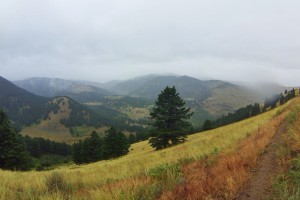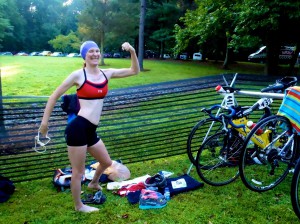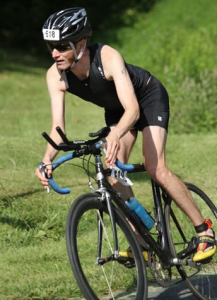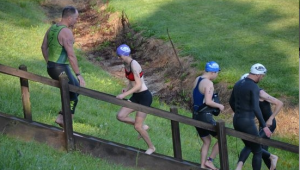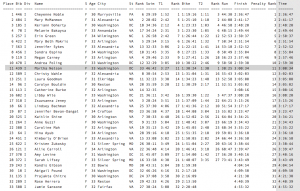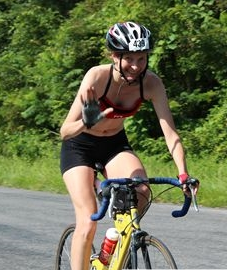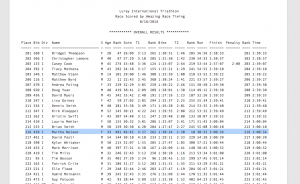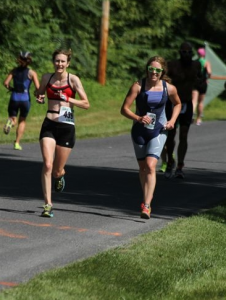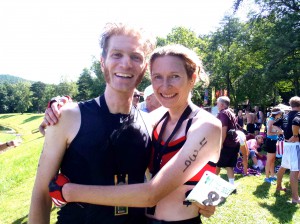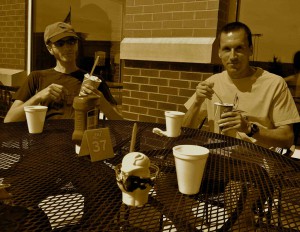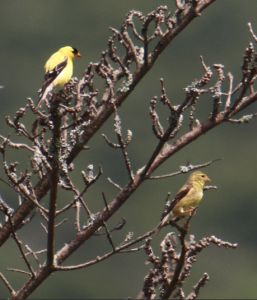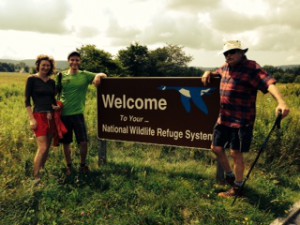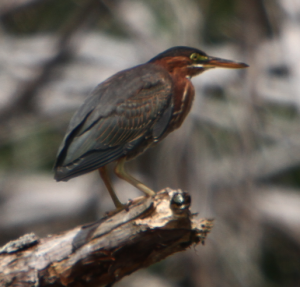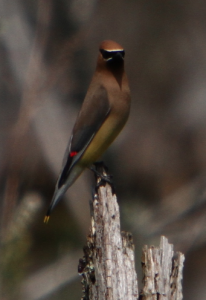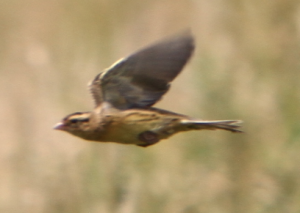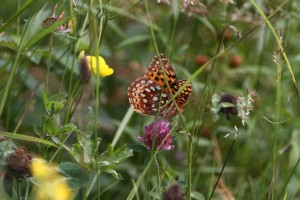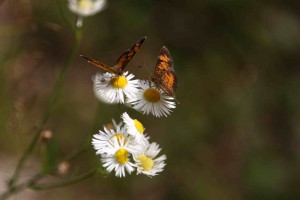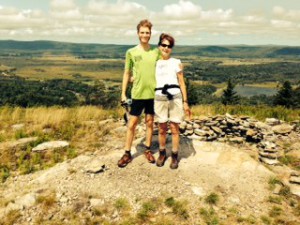Pony, MT
August 23, 2014
The Fool’s Gold 50 mile in Pony, Montana was everything RD Alex Papadopoulis had promised: big mountains, sweeping grasslands, open skies.  Only there were a couple things Alex hadn’t mentioned when he came to WUS back in April to tout the race.  First was the fact that temperatures were in the 40s in Pony and in the 30s as you increased elevation on race day.  Second was the driving freezing rain that made it a tad difficult to appreciate the pretty vistas.  And third was the 6-8 inches of snow that had fallen along the highest part of the 50 mile course the night before the race.  Now, of course all of this was way out of RD Alex’s control.  The mountains of Montana sure have way of deciding for themselves whether they feel like being pretty or not.  The good thing was that Aaron and I had come all this way from DC and had to give it a go despite the conditions.  The other good thing was that I had no idea what I was getting into.  The base of the mountain didn’t seem all that terribly cold.  And I was terribly proud of how much gear I had remembered to bring, all slicked out in arm warmers and gaiters and the ultra-lightweight Patagonia shell I had just splurged on.  I had even remembered my little gel heel pads (more on my heel problems later).  I was beginning to fancy myself as a Trail Runner Esperto.
‘So, who here hasn’t studied the map and read all the emails I’ve been sending out?’ Alex queried the wet, cold huddle of pre-race runners in the dark.  My stomach sunk guiltily, but I knew better than to raise my hand.  After all, Alex had showed us the course back at CBPG in April.  I had the gist.  Big climbs.  Big views.  When there’s ten miles to go you can see Pony one mile away, but don’t finish yet, you still have to go run a 10-mile lollipop loop.  Got it.  Besides, I could always just tag along with someone else.  White House Tom was there in his kilt.
Besides, in all likelihood I was going to have to drop out anyway.  Three days earlier Larry the Acupuncturist had refused to even treat my  left heel because he thought that if he inserted needles into that level of inflammation I’d never return for another treatment.  Only after I had absolutely insisted, and accepted full responsibility for what torture was to come, was Larry willing to place the needles.  My body has been a mess since my food poisoning Highland Sky suffer-fest.  Although my IT band held up okay during the Luray Triathlon last week, my right hamstring was shredded, and my left heel had flared up again on the plane.  I had stuffed my drop bag full of warm clothes on the hunch that if I had to drop out mid-way.
By ‘up there’ I mean one of the peaks of the Tobacco Root Mountains we were going to be climbing. Â The 50 mile course had 11,000 feet of total elevation gain. Â West coast climbs are long, not like the rollers were used to in the East. Â The course was essentially a series of consecutive 5 mile climbs up followed by 5 mile descents. Â The Fools Gold wasn’t the kind of race we had to do serious altitude training for, hovering mainly between 6,000-8,000 feet and peaking out at about 10,000 feet.
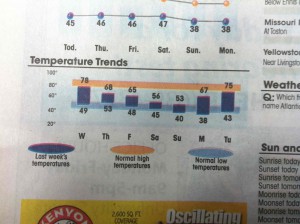
It was still dark and raining when RD Alex Papadopoulis gave his pre-race briefing.  The race was only one year old, so the field was still small.  To boost numbers Alex had added a 50k option that was an out-and-back and started with the 50 mile.  Alex had personally come to WUS last spring to tout the beauty and challenge of the course, which climbed up through the Tobacco Root Mountains in the southwest corner of Montana, near Yellowstone.  We were sold.
There were two VHTRC ‘blue train’ options this summer: Vermont 100 in July or Montana in August. Sean had tried to convince me to go to Vermont, where a large group of VHTRCers were headed and where I could do the 100k. But I balked at the Vermont course description, with its dull gravel roads. At the time of Alex’s visit I still had my first 50 miler at Bull Run looming.  But I promised that if I survived BRR it I’d sign up for what I dubbed the ‘Pony Run’. My Bull Run finish wasn’t entirely convincing, but who could say no to a little August vacation in Yellowstone? Everyone won: Aaron got his challenging 50 miler, I got a couple days tacked on afterwards to go bear-sighting.
There were a couple key points from Alex’s race briefing: (a) some of the trail markers for the 50 mile course had been vandalized, (b) the weather sucked, and (c) if anyone signed up for the 50 miler decided to do the 50k instead he would honor that finish. Â Very tempting.
![Th e Road [photo courtesy of Tom]](http://wussies.net/wp-content/uploads/2014/08/image-1-300x224.jpeg)
When I got back I had cooled off quickly, and scurried to catch a man and woman who had just passed by and get my blood flowing again. A main topic of conversation on the trail was sorting out who was running the 50 miler and who was doing the 50k. Â The division seemed to segregate by sex, with most of the men around me doing the 50 mile and the women doing the 50k. Â I seemed to be the only one who was seriously considering dropping from the 50 mile to the 50k. Â The decision point occurred at mile 12.
After we crested the climb the road turned immediately down. Â As predicted, my hamstring did not much like running down the road, and I let my companions go ahead. Â But when the road turned to trail, I started engaging lateral stability muscles that slowly loosened up the hamstring and I caught up to Tom and the gang. To my great surprise, Aaron was heading towards me up the hill. Â As we passed each other he explained that everyone was doing the 50k version now because the 50 mile course had been closed due to snow. Â I later found out that 6-8 inches of snow had accumulated that night on the ridge, making it too dangerous to send us up.
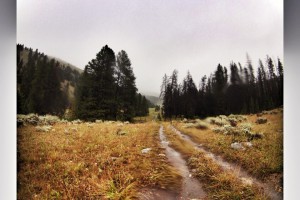 Some of the guys around me were planning to do their first 50 mile race and were pretty disappointed. Â But I was elated. Â I didn’t have to run 50 miles! Â I celebrated with little fist dances. Â I reassured my poor little hamstring that we were heading home. After visiting the aid station at the bottom of the hill, we headed right back up. Â Every time we hit a steep climb (there were some seriously steep mud butt slides) my heel gels would get dislodged and I’d have to do shoe surgery. As the run wore on and I lost fungibility in my fingers the shoe surgeries became more difficult and time-consuming, particularly the initial step of getting the gaiter hook off the bottom lace. Â And every time I lost progressively more body heat.
Some of the guys around me were planning to do their first 50 mile race and were pretty disappointed. Â But I was elated. Â I didn’t have to run 50 miles! Â I celebrated with little fist dances. Â I reassured my poor little hamstring that we were heading home. After visiting the aid station at the bottom of the hill, we headed right back up. Â Every time we hit a steep climb (there were some seriously steep mud butt slides) my heel gels would get dislodged and I’d have to do shoe surgery. As the run wore on and I lost fungibility in my fingers the shoe surgeries became more difficult and time-consuming, particularly the initial step of getting the gaiter hook off the bottom lace. Â And every time I lost progressively more body heat.
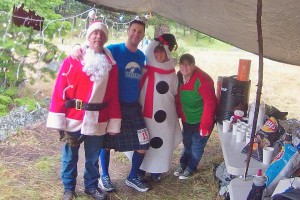
The meanest thing about the course design is that you get to a point where you are a mile from Pony and can see the town, but have to make a hard right turn onto a spur to go run a 10 mile lollipop. Â Fortunately, the lollipop was the coolest part of the course, with a gnarly little switchback climb through the forest that dumped you out onto a beautiful set of ridges atop the mountains. Unfortunately, the combination of high elevation, hard rain, exposed tree-less ridges, and very low temperatures (probably low 30s, based on the face that Tom’s kilt froze and chaffed his thighs) made for pretty dismal weather conditions.
I might have been okay if I hadn’t needed to keep stopping to fumble with my shoes to straighten out those pesky heel pads.  Shaking and with chattering teeth, I couldn’t get my fingers to unclasp the hook and in a fit of frustration decided just to run on my toes and let the pad jar into my arch.  My hamstring wasn’t bothering me as much as I had feared, but I had strained some tendons in compensation.  Between the cold and my tweaks, my feet weren’t at the top of my list of concerns.  There was supposed to be a volunteer at the top of the 4-mile climb with some water, so I hatched a plan that I would suck it up until then and then maybe he could help me rid myself of the useless pads entirely.
But that 4-mile stretch was by far the slowest of the race, and I began to doubt whether this volunteer guy actually existed (Aaron shared the same sentiment and doubt).  In a fit of do-or-die determination, I plopped down in the freezing rain and willed my fingers to unhinge my shoes.  The wind blew in my face, and the longer I idled there, the harder it became to maneuver my numbing fingers.  I started to mumble to myself like a kindergarten teacher gone mental: ‘Okay, take the clasp off the shoe.  Good girl!  Untie the shoes, untie the shoes,’ I chanted.  My jaw was shaking uncontrollably.  ‘Tug, tug.  There you go.  Go–od girl.’  I yanked out the gel pad and held it in the air like a trophy.  It flopped in my hand like a fish.  ‘Come on, tie the laces back up.  There you go.  Good job.’  I made a feeble attempt to relatch the metal gaiter clasp, but knew it was futile and let them flap at my ankles.
When I lurched myself up off the rock I could feel how sore and tight my undertrained and overcompensating quads were.  I pulled my hood tighter around my head and retracted my hands within my jacket sleeves, clenching the heel pads in my paw. I ran the next section hard, even most of the uphills.  I couldn’t understand how I could still be so damn cold when I was running my engine so high.  My arm warmers were thick and would have provided good warmth if they hadn’t kept falling down and clumping around my wrists.  I tried to pull them up through my jacket, but my hands had been utterly useless since the final shoe surgery.
IÂ thought about how every race I seem to find a new way to be miserably uncomfortable. Â At Bull Run I felt great except for the whole miserable puking thing. Â At Highland Sky I managed not to puke but my IT band felt like daggers were splitting it. Â Here at the Pony run my stomach was holding out beautifully, I had managed to navigate my minefield of injuries thus far, yet I had found a new way to suffer: numb and chilled to the bone, so cold I was almost hyper-ventilating. I finally came across the ‘aid station in the middle of nowhere’ where they were able to give me some almost-hot water to drink. Â More importantly, the aid station marked the end of the exposed frozen tundra stretch of the race, and from there we headed back into the shelter of the woods. Â After a couple miles of rolling, it was all downhill to the finish.
It would have been a lot of fun to fly down that descent through the forest, and a healthy version of me would have loved it.  But today, given the state of all my injuries, I played it very conservative.  The prize for first place for the 50 miler was a fatty $300 check, which I figured they would give to us even though we got pushed down to the 50k.  So I had a sliver of competitive drive.  But my overarching goal was to finish in one piece, with nothing too wrecked, so Aaron and I could enjoy our remaining days hiking in Yellowstone.  My injuries started to flare pretty badly during those last two downhill miles on the road, with my IT band howling loudest, but I tried to keep things quiet.
As soon as I finished, Aaron and I jumped in our Kia and blasted the heat until my drop bag arrived with all my warm clothes in it.  All the VHTRCers survived the day, and no one seemed terribly disappointed that the race had been curtailed to 50k.  Aaron had a good race, but noticed the altitude on the climbs (notably, only local men finished ahead of him). There was a nice post-race party held in the school in Pony, with a nice spread of food (pulled pork bbq, pesto potato salad, fruit salad, baked beans) and bottles of local beer.  Overall, I thought the race was extremely well organized, and I hope the event succeeds.  There there were ample friendly volunteers and well-stocked aid stations that were thankfully prepared for the conditions (the tents and hot ramen noodles were particularly welcome).  I’m sure it was a tough call for Alex to make to divert the 50 milers onto the 50k course, but I think it was a good call, as few runners would have been prepared for such conditions.  There seemed to be good community support from the residents of Pony, as well as the main sponsor Mystery Ranch.
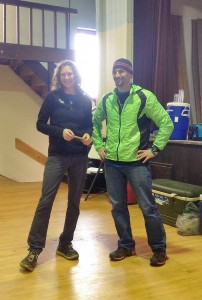
The one thing I found perplexing was why I didn’t win the $300 in prize money. Â I understand that the prize purse was technically for the winner of the 50 mile race. Â But given that the 50 milers were forced to change course to the 50k, it seemed natural that the structure of the prizes would be likewise adjusted. Â The money had already been set aside after all. Â I wasn’t 100% sure I’d be getting the prize money, but I had promised the gang dinner on me if I did. Â It’s a bit blurry, but Gary K snapped a photograph of me looking absolutely perplexed after receiving my first-place prize: a palm-sized piece of wood cut in the shape of Montana. Â I know we’re terribly spoiled back East by Horton schwag, the beautiful Uwharrie ceramics, and the Patagonia fleece I got this year at Highland Sky that is the warmest thing in the world. Â But this looked like the kind of thing you have have to pretend to love because your kid made it for you at school.
~ Â Â Â Â Â Â Â Â Â ~ Â Â Â Â Â Â Â Â Â ~
Now that I had the hard part of the trip out of the way, it was time to enjoy the three days of vacation in Yellowstone we had set aside. Â I had made poor Aaron drag about 20 lbs of photography equipment along, because I had a hunch about a new way to vacation: My passion for wildlife + Aaron’s passion for photography = Wildlife photography trips We had already pilot-tested the plan in Canaan Valley with Aaron’s parents. Â We seemed to have it down: I’m in charge of (a) route orchestrating, (b) animal spotting, and (c) animal identification (when possible), while Aaron covers the whole camera bit.
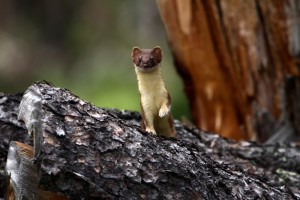
On one hand, our Yellowstone trip was a dismal failure: in our two days in the park we never saw a bear, not even a black bear.  But on the other, it was a wild success: we had discovered a fantastic new way to vacation.  In addition to capitalizing on our personal passions, taking pictures of wildlife has several other advantages: (a) the challenge of finding wildlife has all the sporting fun of a hunt (only without harming any poor fluffy animals); (b) it can be done on a hike when wee are feeling vigorous, or alternatively from a car when we are spent; (c) we don’t have to bother with crowds; (d) we don’t have to buy souvenirs, as they’re all on his camera; and, critically, (e) my  knowledge  of wildlife is incomplete, so if we have a photo record of what we see when can consult books, the internet, or my brother Fred, so we learn as we go.
